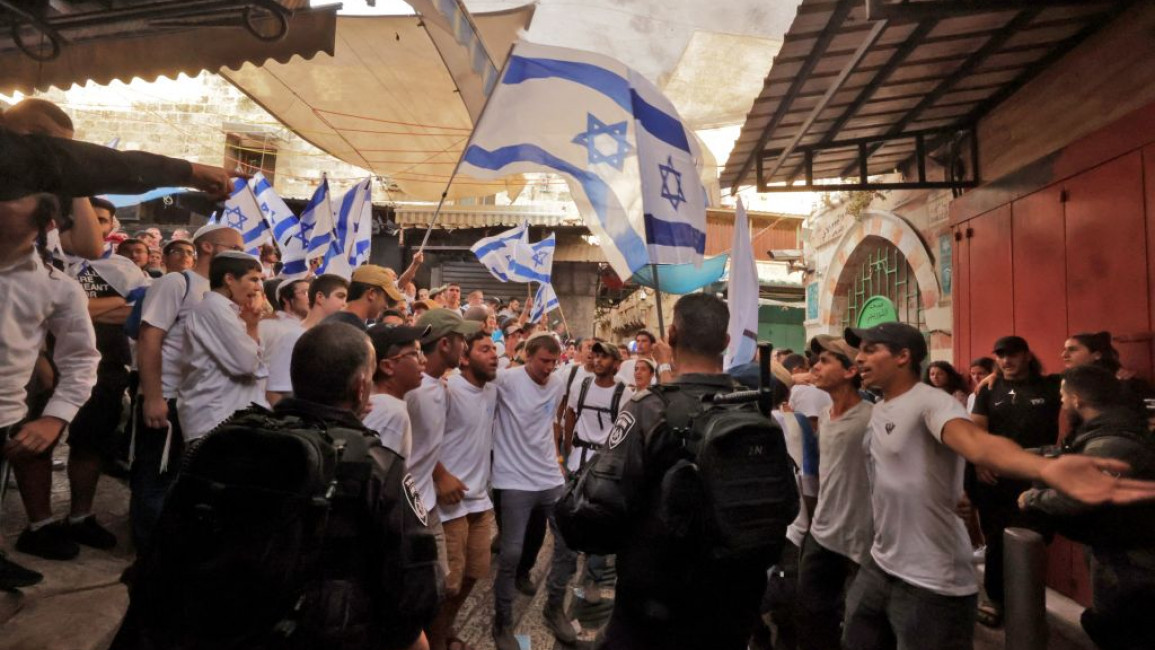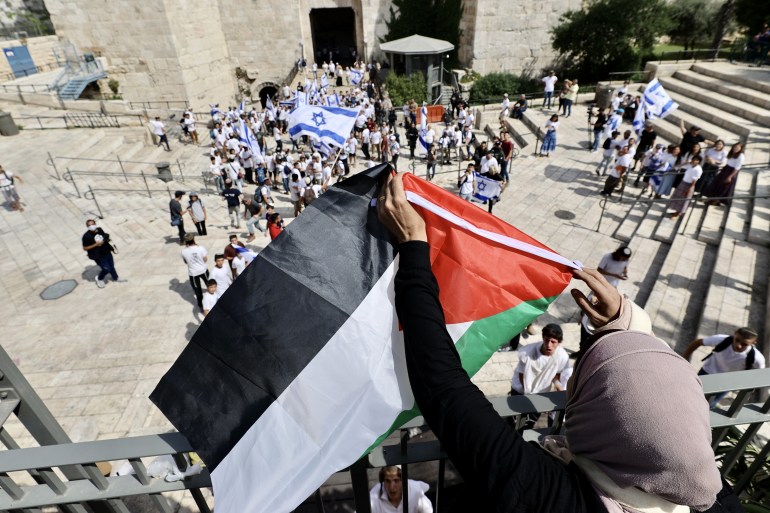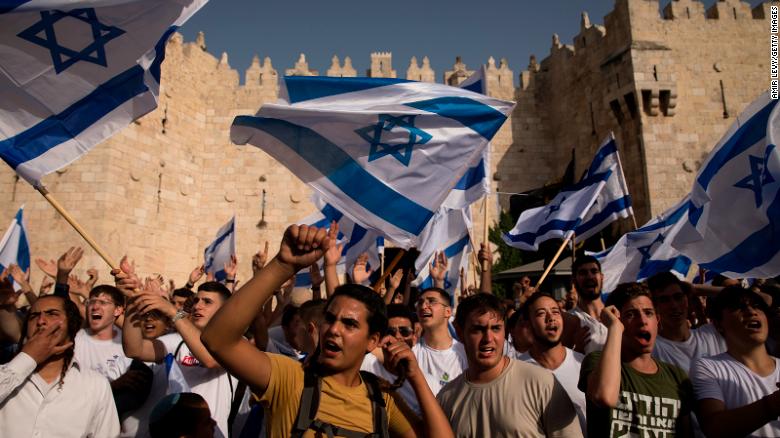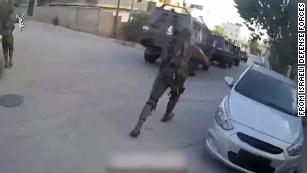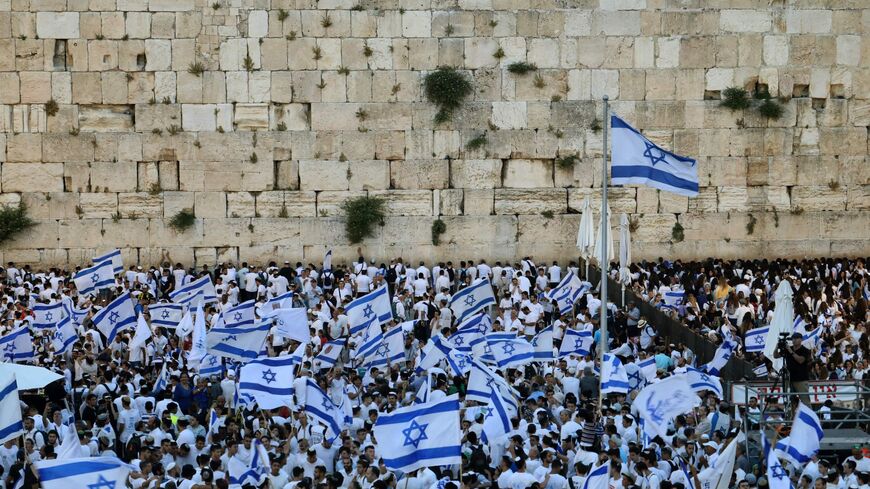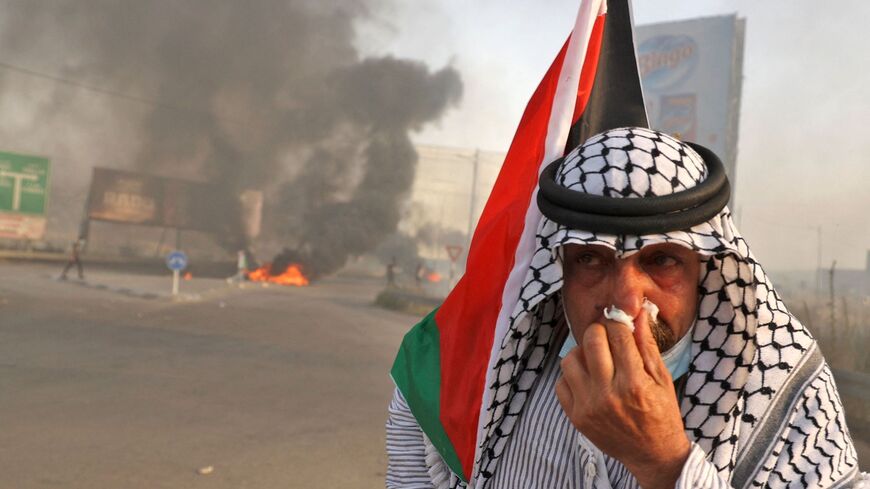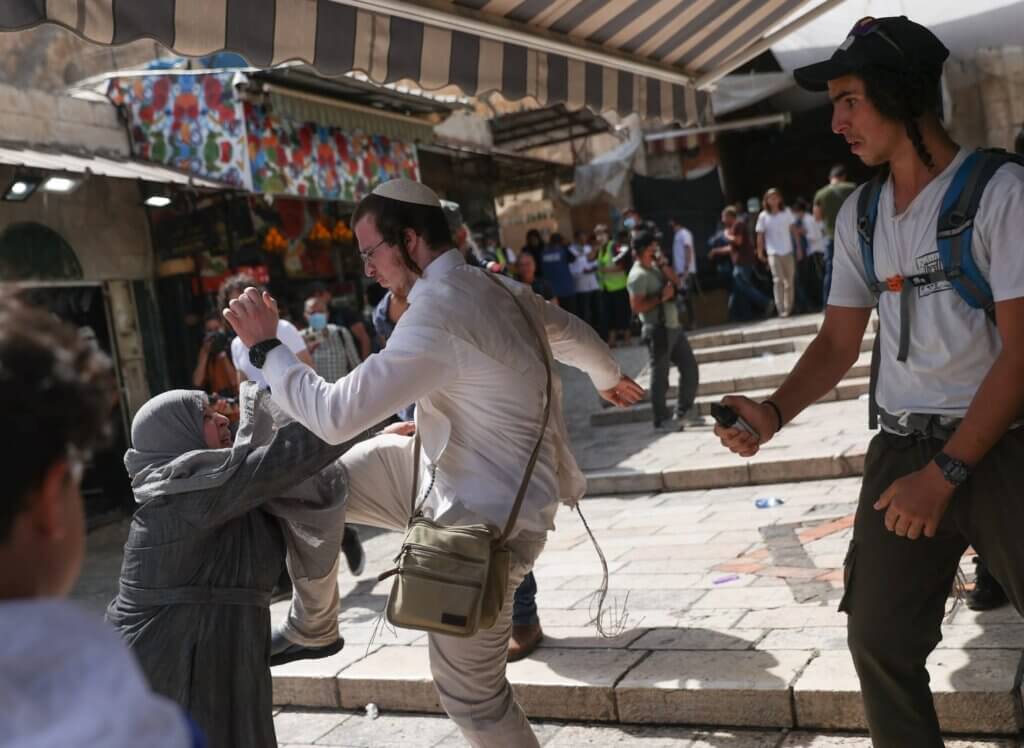An estimated 70,000 Israeli settlers participated in the annual flag march in occupied East Jerusalem on Sunday, with some crowds chanting “Death to Arabs.”
MONDOWEISS
ISRAELI SETTLER ATTACKS PALESTINIAN WOMAN IN JERUSALEM’S OLD CITY DURING THE ‘JERUSALEM DAY’ FLAG MARCH, MAY 29, 2022. THE FLAG MARCH IS AN ANNUAL DISPLAY OF RIGHT-WING ISRAELI NATIONALISM AND ANTI-PALESTINIAN RACISM INTENDED TO CELEBRATE ZIONIST FORCES’ SEIZURE OF EAST JERUSALEM IN 1967. (PHOTO: OHAD ZWEIGENBERG/SOCIAL MEDIA)
Israel’s flag march, an annual display of right-wing Israeli nationalism and anti-Palestinian racism, took place on Sunday afternoon, stoking tensions in Jerusalem and across the occupied Palestinian territory.
Israeli media reported that Sunday’s flag march was the largest in years, with an estimated 70,000 Israelis participating in the parade.
Palestinian leaders condemn march, warn of retaliation from Gaza
10:55pm (7:55PM GMT)
Leading up to the march, Palestinian factions in Gaza denounced the parade, threatening retaliation against Israel.
“The flag march plan is an explosive barrel and will blow the region up,” the factions said in a joint statement in a press conference held in Gaza City on Thursday.
The factions called on Palestinians to defend Jerusalem, and encouraged people to establish their presence in the Al-Aqsa Mosque compound and across the city.
The groups said that Israel would bear the responsibility of any aggressions made against Palestinians, adding “We will use every possible means to defend our people, secret places, and our Aqsa Mosque.
Last year, the military wings of Hamas and Islamic Jihad in Gaza fired rockets into Israel following the flag march in Jerusalem. The rocket fire came after the factions gave Israel an ultimatum, to stop the march, and retreat its forces who were attacking the al-Aqsa Mosque compound and suppressing peaceful protests in Sheikh Jarrah at the time.
Israel then launched an 11-day offensive on the Gaza Strip that lead to more than 200 Palestinians being killed, including over 60 children.
In the West Bank, the Palestinian Authority condemned the flag march and the attacks on Palestinians in the city, with Prime Minister Mohamemd Shtayyeh calling for sanctions to be placed on Israel.
Palestinian President Mahmoud Abbas’ spokesperson Nabil Abu Rdeineh said in a statement: “It is not possible to achieve security and stability in our region, as long as Israel continues its war on our people, their land and their holy sites, and as long as it deals as a state above the law and rejects the resolutions of international legitimacy and the foundations of the peace process.”
Jordan also condemned the march and the storming of Israeli settlers on the Al-Aqsa Mosque compound earlier in the day.
Tareq Hajjaj contributed to this report from Gaza.
Settlers attack Palestinian homes in Sheikh Jarrah, Nablus
10:28pm (7:28pm GMT)
Israeli settlers reportedly attacked Palestinian homes in the occupied East Jerusalem neighborhood of Sheikh Jarrah under police protection, according to Palestinian media.
Wafa News Agency reported that settlers raided the al-Samoud area of the neighborhood along with police forces, throwing stones at Palestinians homes and vandalizing vehicles. Wafa reported that live ammunition was fired in the neighborhood.
In the Nablus district of the northern occupied West Bank, Israeli settlers attacked the village of Burin, which borders the extremist Yitzhar settlement, and is the frequent site of settler attacks.
According to Wafa, the settlers attacked the homes of Palestinian residents with Molotv cocktails, sparking confrontations in the village.
The settler attacks came hours after an estimated 50,000 right-wing Israeli settlers paraded through Jerusalem for the annual ‘flag march’, harassing and assaulting Palestinians, and shouting racist chants along the way.

ISRAELI TROOPS ATTACK A DEMONSTRATION AGAINST THE ANNUAL NATIONALIST “FLAG MARCH” THROUGH JERUSALEM, AT THE ISRAELI-CONTROLLED HAWARA CHECKPOINT NEAR NABLUS IN THE WEST BANK ON MAY 29, 2022. (PHOTO: SHADI JARAR’AH/APA IMAGES)
Hundreds of Palestinians injured in Jerusalem, West Bank
10:18pm (7:18pm GMT)
Hundreds of Palestinians have been injured across the occupied West Bank and East Jerusalem as Israeli forces suppress protests that erupted in response to the far-right Israeli flag march in Jerusalem today.
Palestinians in East Jerusalem came under attack from both Israeli settlers and police forces, with at least 62 injuries, including 23 hospitalizations, according to the Palestinian Red Crescent (PCRS).
PCRS reported that injuries included rubber-coated steel bullet wounds, beatings and pepper spray.
Israeli settlers were documented as pepper spraying and assaulting Palestinian bystanders during the march, according to local Palestinian media. In at least one instance, a young settler was filmed pepper spraying and attempting to kick a Palestinian woman in the Old City.
Protests were reported in districts across the West Bank, including Hebron, Bethlehem, Ramallah, Nablus, and Qalqilya, as Palestinians took to the streets to protest the flag march.
Earlier in the day, hundreds of Palestinians marched through the streets of Ramallah in a counter protest, raising Palestinian flags as they walked through the city.
PCRS reported over 163 injuries in the West Bank, consisting of live ammunition, rubber-coated steel bullets, and tear gas. Local Palestinian media reported dozens of live ammunition injuries across the West Bank.
The flag march on Sunday came amidst lots of anger and frustration in the occupied territory, following the killing of three Palestinian children last week, and the killing of Palestinian veteran journalist Shireen Abu Akleh.
Crowds chant ‘Death to Arabs’
8:53pm (5:53 pm GMT)
Thousands of far-right Israeli settlers participated in the annual flag march in occupied East Jerusalem on Sunday, with some crowds chanting “Death to Arabs.”
According to Al Jazeera, thousands of Israeli settlers marched through the Old City carrying Israeli flags and singing religious songs, chanting nationalistic slogans, and hurling racial-epithets at Palestinians.
Some of the chants were “the Jewish nation lives,” “Death to Arabs,” and “Let your village burn down” – all popular chants commonly featured at the annual parade.
The march set off at 4pm local time (1:00pm GMT) and is scheduled to end at 10pm (7:00pm GMT), though the effects of the march are expected to to be felt across Palestinian neighborhoods in Jerusalem and cities across the West Bank into the night, as Israeli forces continue to crack down on protesters.
Israel’s flag march, an annual display of right-wing Israeli nationalism and anti-Palestinian racism, is set to take place on Sunday afternoon, and is already stoking tensions in Jerusalem and across the occupied Palestinian territory.

ISRAELI SETTLERS CONGREGATE NEAR JERUSALEM’S DAMASCUS GATE DURING THE ‘FLAG MARCH’ IN JERUSALEM ON MAY 29, 2022. (PHOTO: JERIES BSSIER/APA IMAGES)
Settlers storm Al-Aqsa Mosque under police protection
3:48pm (12:48pm GMT)
On Sunday morning ahead of the march, hundreds of far-right settlers, including Israeli MK Itamar Ben-Gvir, stormed the al-Aqsa Mosque compound under heavy Israeli police protection. According to Israeli media, close to 2,000 settlers entered the compound in smaller groups.
Local media reported that some of the settlers danced, waved Israeli flags, and performed prayer rituals at the site, angering Palestinian worshipers, as Jewish worship at the site is no permitted according to a decades-long agreement between Israel and Jordan, the official custodian of the mosque.
The Times of Israel reported that Israeli police did not intervene as the settlers performed different rituals at the site, despite the blatant violation of the status quo.
According to reports, a number of Palestinian worshipers were barricaded inside the al-Qibli prayer hall of the Al-Aqsa Mosque – the site of intense attacks by Israeli forces earleir this year during the holy month of Ramadan.
Some Palestinians threw stones at police, while Israeli forces fired rubber-coated steel bullets at worshipers. Haaretz reported that at least 18 Palestinians were detained from the compound “for disorderly conduct, rioting and assault on police officers or civilians.”
Israeli police also reportedly prevented a number of Palestinian journalists from entering the compound.
Several reports were made throughout the morning of Israeli settlers harassing Palestinians throughout the Old City, while Israeli police were filmed violently detaining Palestinians in the area.
Translation: The occupation forces abused a young Jerusalemite at the moment of his arrest from Al-Wad Street in the Old City of occupied Jerusalem.
Translation: The occupation forces assaulted two girls in the Old City of occupied Jerusalem.
Times of Israel reported settler youth singing “I will take one revenge for both my eyes against Palestine — damn them,” as they walked through the city. One settler youth reportedly told his friends, “The next time you see Arabs running, stick out your legs and trip them.”
Palestinian Authority-owned Wafa News Agency reported that groups of settlers “shouted profanities at Palestinians and verbally assaulted some of them under police protection,” as they made their way through the Old City.
Settlers reportedly assaulted and beat up three Palestinians, causing them minor injuries, including one hospitalization, Wafa reported.
Outside the Damascus Gate entrance to the Old City, Israeli police closed off the area and arrested three Palestinians. Israel began cracking down on Palestinians at Damascus Gate on Saturday evening, as smaller groups of settlers marched in the area with Israeli flags.
One video showed Israeli police detaining a Palestinian woman and subsequently beating her inside the permanent police checkpoint outside the gate.
According to the media, around 3,000 Israeli police have been deployed across Jerusalem in anticipation of the march Sunday afternoon.
What is the ‘Flag March’?
The march takes place every year on Israel’s “Jerusalem Day”, and marks the state’s capture of occupied East Jerusalem during the 1967 war, and the subsequent annexation of the territory – a move not recognized by the international community.
The parade, which makes its way through East Jerusalem, the Muslim quarter of the Old City and ends at the Western Wall, has become symbolic of Israeli nationalism and attempts to assert Israeli dominance and sovereignty over the city and its Palestinian residents.
Every year the provocative march features thousands of settler youth who wave Israeli flags as they march through the city, often harassing Palestinians and chanting racial epithets along the way.
Among the most popular chants featured at the annual march, are “Death to Arabs,” “may your village burn,” and “a second Nakba is coming,” referring to the Nakba, or ‘catastrophe’ in Arabic, when thousands of Palestinians were massacred by Zionist militias and over 750,000 were forcibly expelled from their homes in 1948.
While the settlers are escorted through the city under heavy Israeli police protection, Palestinians in the Old City are usually forced to shutter the doors to their businesses, and their movement is severely restricted.
Last year, the flag march sparked the devastating 11-day Israeli offensive in Gaza that killed hundreds of Palestinians, after Palestinian factions in Gaza followed through on threats to fire rockets into Israel if the march took place.
